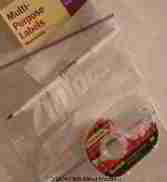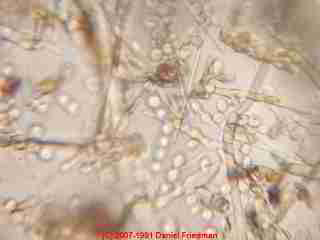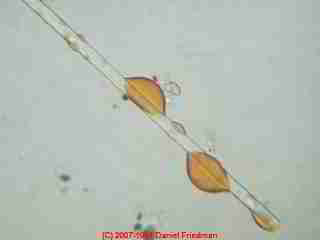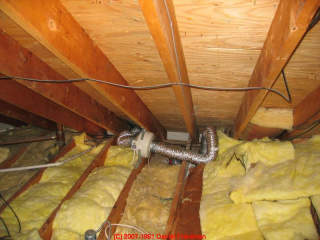 Fiberglass Contamination Test Procedure for buildings
Fiberglass Contamination Test Procedure for buildings
- POST a QUESTION or COMMENT about test procedures for screening buildings for abnormal levels of fiberglass dust or mold
Building tests for fiberglass contamination:
Tthis document provides suggestions for easy, low-cost methods to screen a building for fiberglass hazards and fiberglass insulation contamination in residential or commercial buildings.
Here we provide some suggestions regarding screening for fiberglass dust exposure in buildings in order to detect unusual or high levels of fiberglass insulation or other fiberglass fragments indoors in air or dust. We discuss both large and ultra-fine fiberglass particles and fragments and how to screen and test for fiberglass indoors.
InspectAPedia tolerates no conflicts of interest. We have no relationship with advertisers, products, or services discussed at this website.
- Daniel Friedman, Publisher/Editor/Author - See WHO ARE WE?
Guide to Rapid, Low-Cost Procedures for Screening buildings for Fiberglass Dust, Particle, or Fragment Contamination
There are three basic approaches to screening a building or building area for airborne fiberglass exposure (1 - 3 below) but before you read these please note these "bottom line OPINIONS"
- Simple damp wiping and HEPA vacuuming can safely clean up most types of indoor dust including fiberglass that might have been tracked into a building or released during construction or demolition;
- The consensus among most experts is that the principle fiberglass hazards for building occupants might be skin or lung irritation if you are exposed to high levels of that dust
- Visual Inspection for Fiberglass Contamination Sources:
A very expert, thorough visual inspection of conditions that would affect insulation particle movement between areas, such as the HVAC system details, ductwork condition and materials, exposed insulation in various areas, expected air movement between areas. our photos (above) show typical fiberglass insulation in two attics.
The color of fiberglass insulation may help identify its manufacturer and is primarily the result of binder materials.
Identification of fiberglass insulation by visual inspection (the naked eye) is discussed
at FIBERGLASS HAZARDS and in general is quite easy.
But there may be sources of fiberglass particles indoors that are less obvious, such as damaged HVAC ductwork insulated with fiberglass.
Our detailed article on how to recognize fiberglass duct insulation and its characteristics and hazards is
at FIBERGLASS HVAC DUCTS. - How to Collect Settled Dust for Fiberglass Contamination Testing:
To look for high levels of fiberglass particles in settled dust as an indicator of exposure we may collect settled dust from appropriate building locations and surfaces.
Also we can often trace fiberglass in building dust samples to its source by comparing resins and other details to various samples of actual building insulation (if needed). Tape Sampling for Dust Collection:
Tape Sampling for Dust Collection:
A reasonable, and inexpensive initial screen for indoor fiberglass particle levels is to use adhesive tape sampling to collect a settled dust sample from a horizontal surface that has not been cleaned for two weeks or longer.
Don't collect from such a dirty surface that the tape sample is obscured with debris (thick with dust bunnies), and don't collect a sample from a surface that was cleaned very recently, unless you are evaluating the efficacy of that cleanup.
Use the easy and low-cost mold or dust particle sampling procedure using clear adhesive tape and ZipLok™ baggies
at TEST KIT for DUST, MOLD, PARTICLES: INSTRUCTIONS.
At How to How to Test for Mold in Insulation we also describe fiberglass dust screening recommendations, including just where and how to collect dust samples to look for fiberglass contamination, in more detail and include photos of highly-contaminated fiberglass.
Depending on the forensic lab used, costs vary a bit, but are typically $50./tape sample.
To keep costs down, most experts either collect two samples per building floor, or they concentrate (as I prefer) on the one or two rooms where occupants spend the most time, such as a bedroom and perhaps a family or TV room.
Bulk sampling, the analysis of actual samples of insulation, are typically $100./sample and are not necessary in most cases. - Using Air Tests or Air Sampling to Screen for Fiberglass?
Air tests to look for airborne fiberglass at a specific time, in our experience is unreliable.
In particular, a negative result is the least reliable among these three methods, as the level of airborne particles varies enormously from minute to minute in building because of many varying conditions such as occupancy, open or shut windows or doors, HVAC systems operating or not, other fans operating or not, level of mechanical disturbance of local dust, and even elevation above floor level of the air sample collector.
See FIBERGLASS DETECTION in BUILDING AIR & DUST for details.
 We discuss these variables in more detail
We discuss these variables in more detail
at MOLD TESTING METHOD VALIDITY where we provide graphic evidence of orders of magnitude variation in sample results, and air sampling is further criticized
at MOLD LEVEL IN AIR, VALIDITY - where we describe airborne mold spore counts - the same fallacies apply to fiberglass or other airborne particle counts.
Our photo (left) shows severe mold contamination found in fiberglass insulation over a wet basement floor.
It is possible to conduct longer-term air sampling, either continuously (an Anderson continuous air monitoring sampler) or intermittently (Allergenco time lapse impaction sampler) but even
then there may be large errors in the results of such (much more costly) monitoring and testing, unless we establish that the building use and occupancy are representative of normal conditions. - Bulk Sample Testing for Fiberglass Source Identification:
Bulk sample (samples of actual insulating material) examination can be useful in determining the condition of fiberglass insulation, the degree to which it has been damaged so as to produce large numbers of small fragments, and the resins and binders used that may assist in later correlating building dust with specific insulation sources.
We can also identify old, dirty fiberglass that may be contaminated with insect fragments, insect fecals, animal allergens (mice, rodents), or with harmful mold.
See MOLD in FIBERGLASS INSULATION -
and MOLDY INSULATION MAY LOOK CLEAN for details. 
Care in lab processing of fiberglass samples is critical,
whether from dust, air, or bulk material.
We have found that most microscopists easily identify large fiberglass particles, but we suspect that at least some studies of the level of fiberglass dust in buildings may have failed to adequately screen for very small (1-4 u) fiberglass fragments that are produced in some circumstances
- these particles are difficult to see unless the microscopist is familiar with the issues and unless s/he makes very careful adjustments to both mounting media and the microscope itself.
Lab identification of fiberglass insulation is
at LAB IDENTIFICATION OF FIBERGLASS and is also not difficult, though as we cite in this article, care is necessary to include ultra-small fiberglass fragments if performing a study of occupant exposure to fiberglass particles.
Fiberglass fragment issues are discussed
at FIBERGLASS FRAGMENT HAZARDS in AIR or DUST.In that article we also discuss techniques which permit the forensic microscopy lab to identify the source or reservoir of particular fiberglass fragments in a building, sorting out among many possible fiber sources to pinpoint the particular problem such as damaged building insulation, damaged HVAC duct work, or other particle sources.
Finally, we discuss how to distinguish among types of insulating and other fibers, comparing various types of fiberglass insulation, mineral wool insulation, asbestos insulation, and other fibers.
Our separate article on FIBERGLASS FRAGMENT HAZARDS in AIR or DUST and HVAC duct work insulation hazards contains additional discussion about possible air quality and health concerns which may be associated with exposure to fiberglass dust.
Fiberglass Carcinogenicity or Hazard Research Citations
- Fiberglass carcinogenicity: "Glass Wool Fibers Expert Panel Report, Part B - Recommendation for Listing Status for Glass Wool Fibers and Scientific Justification for the Recommendation", The Report on Carcinogens (RoC) expert panel for glass wool fibers exposures met at the Sheraton Chapel Hill Hotel, Chapel Hill, North Carolina on June 9-10, 2009, to peer review the draft background document on glass wool fibers exposures and make a recommendation for listing status in the 12th Edition of the RoC.
The National Institute of Environmental Health Sciences is one of the National Institutes of Health within the U.S. Department of Health and Human Services.
The National Toxicology Program is headquartered on the NIEHS campus in Research Triangle Park, NC.
The National Institute of Environmental Health Sciences is one of the National Institutes of Health within the U.S. Department of Health and Human Services.
The National Toxicology Program is headquartered on the NIEHS campus in Research Triangle Park, NC.
Following a discussion of the body of knowledge, the expert panel reviewed the RoC listing criteria and made its recommendation.
The expert panel recommended by a vote of 8 yes/0 no that glass wool fibers, with the exception of special fibers of concern (characterized physically below), should not be classified either as known to be a human carcinogen or reasonably anticipated to be a human carcinogen.
The expert panel also recommended by a vote of 7 yes/0 no/1 abstention, based on sufficient evidence of carcinogenicity in well-conducted animal inhalation studies, that special-purpose glass fibers with the physical characteristics as follows longer, thinner, less soluble fibers (for 1 example, > 15 μm length with a kdis of < 100 ng/cm2/h) are reasonably anticipated to be a human carcinogen for the listing status in the RoC.
The major considerations discussed that led the panel to its recommendation include the observations of tumors in multiple species of animals (rats and hamsters). Both inhalation and intraperitoneal routes of exposure produced tumors, although inhalation was considered more relevant for humans. - World Health Organization International Agency for Research on Cancer - IARC Monographs on the Evaluation of Carcinogenic Risks to Humans - VOL 81 Man-Made Vitreous Fibers, 2002, IARCPress, Lyon France, pi-ii-cover-isbn.qxd 06/12/02 14:15 Page i - World Health Organization, 1/21/1998.
- Fiberglass insulation is an example of what IARC refers to as man made vitreous fiber - inorganic fibers made primarily from glass, rock, minerals, slag, and processed inorganic oxides.
This article provides enormous detail about fiberglass and other vitreous fibers, and includes fiberglass exposure data. - WHO- World Health Organization - IARC MONOGRAPHS ON THE IDENTIFICATION OF CARCINOGENIC HAZARDS TO HUMANS large PDF over 6MB)
https://publications.iarc.fr/ENG/Monographs/vol81/mono81-6A.pdf - article details
https://publications.iarc.fr/ENG/Monographs/vol81/mono81-6C.pdf - studies of cancer in experimental animals in re vitreous fibers such as fiberglass;
https://publications.iarc.fr/ENG/Monographs/vol81/mono81-6E.pdf - summary of data reported & evaluation
https://publications.iarc.fr/ENG/Monographs/vol81/mono81-6F.pdf for the article references
To search the IARC monographs on various environmental concerns and carcinogens, use https://publications.iarc.fr/ENG/Monographs/PDFs/index.php - Also see our more-complete citations set
at FIBERGLASS HAZARD RESEARCH
...
Continue reading at FIBERGLASS HAZARDS or select a topic from the closely-related articles below, or see the complete ARTICLE INDEX.
Or see FIBERGLASS PARTICLE CONTAMINATION TEST FAQs - questions and answers posted originally on this page
Or see these
Recommened Articles
- FIBERGLASS HAZARDS - home
- AIR FILTERS, FIBERGLASS PARTICLES
- DUST ANALYSIS for FIBERGLASS
- FIBERGLASS ASBESTOS COMBINATIONS
- FIBERGLASS DETECTION in BUILDING AIR & DUST
- FIBERGLASS ENVIRO-SCARE
- FIBERGLASS FRAGMENT HAZARDS in AIR or DUST
- FIBERGLASS HAZARD RESEARCH
- FIBERGLASS INSULATION EXPOSURE LIMITS
- FIBERGLASS PARTICLE CONTAMINATION TEST
- FIBERGLASS REINFORCED PLASTICS
- FIBERGLASS SHEDDING from MATTRESSES
- FORMALDEHYDE in FIBERGLASS INSULATION
Suggested citation for this web page
FIBERGLASS PARTICLE CONTAMINATION TEST at InspectApedia.com - online encyclopedia of building & environmental inspection, testing, diagnosis, repair, & problem prevention advice.
Or see this
INDEX to RELATED ARTICLES: ARTICLE INDEX to FIBERGLASS HAZARDS
Or use the SEARCH BOX found below to Ask a Question or Search InspectApedia
Ask a Question or Search InspectApedia
Questions & answers or comments about test procedures for screening buildings for abnormal levels of fiberglass dust or mold.
Try the search box just below, or if you prefer, post a question or comment in the Comments box below and we will respond promptly.
Search the InspectApedia website
Note: appearance of your Comment below may be delayed: if your comment contains an image, photograph, web link, or text that looks to the software as if it might be a web link, your posting will appear after it has been approved by a moderator. Apologies for the delay.
Only one image can be added per comment but you can post as many comments, and therefore images, as you like.
You will not receive a notification when a response to your question has been posted.
Please bookmark this page to make it easy for you to check back for our response.
IF above you see "Comment Form is loading comments..." then COMMENT BOX - countable.ca / bawkbox.com IS NOT WORKING.
In any case you are welcome to send an email directly to us at InspectApedia.com at editor@inspectApedia.com
We'll reply to you directly. Please help us help you by noting, in your email, the URL of the InspectApedia page where you wanted to comment.
Citations & References
In addition to any citations in the article above, a full list is available on request.
- "Glass Wool Fibers Expert Panel Report, Part B - Recommendation for Listing Status for Glass Wool Fibers and Scientific Justification for the Recommendation", The Report on Carcinogens (RoC) expert panel for glass wool fibers exposures met at the Sheraton Chapel Hill Hotel, Chapel Hill, North Carolina on June 9-10, 2009, to peer review the draft background document on glass wool fibers exposures and make a recommendation for listing status in the 12th Edition of the RoC. The National Institute of Environmental Health Sciences is one of the National Institutes of Health within the U.S. Department of Health and Human Services. The National Toxicology Program is headquartered on the NIEHS campus in Research Triangle Park, NC.
Following a discussion of the body of knowledge, the expert panel reviewed the RoC listing criteria and made its recommendation. The expert panel recommended by a vote of 8 yes/0 no that glass wool fibers, with the exception of special fibers of concern (characterized physically below), should not be classified either as known to be a human carcinogen or reasonably anticipated to be a human carcinogen. The expert panel also recommended by a vote of 7 yes/0 no/1 abstention, based on sufficient evidence of carcinogenicity in well-conducted animal inhalation studies, that special-purpose glass fibers with the physical characteristics as follows longer, thinner, less soluble fibers (for 1 example, > 15 μm length with a kdis of < 100 ng/cm2/h) are reasonably anticipated to be a human carcinogen for the listing status in the RoC. The major considerations discussed that led the panel to its recommendation include the observations of tumors in multiple species of animals (rats and hamsters). Both inhalation and intraperitoneal routes of exposure produced tumors, although inhalation was considered more relevant for humans.
- World Health Organization International Agency for Research on Cancer - IARC Monographs on the Evaluation of Carcinogenic Risks to Humans - VOL 81 Man-Made Vitreous Fibers, 2002, IARCPress, Lyon France, pi-ii-cover-isbn.qxd 06/12/02 14:15 Page i - World Health Organization, 1/21/1998. - Fiberglass insulation is an example of what IARC refers to as man made vitreous fiber - inorganic fibers made primarily from glass, rock, minerals, slag, and processed inorganic oxides. This article provides enormous detail about fiberglass and other vitreous fibers, and includes fiberglass exposure data.
- WHO- World Health Organization - IARC MONOGRAPHS ON THE IDENTIFICATION OF CARCINOGENIC HAZARDS TO HUMANS large PDF over 6MB)
https://publications.iarc.fr/ENG/Monographs/vol81/mono81-6A.pdf - article details
https://publications.iarc.fr/ENG/Monographs/vol81/mono81-6C.pdf - studies of cancer in experimental animals in re vitreous fibers such as fiberglass;
https://publications.iarc.fr/ENG/Monographs/vol81/mono81-6E.pdf - summary of data reported & evaluation
https://publications.iarc.fr/ENG/Monographs/vol81/mono81-6F.pdf for the article references
To search the IARC monographs on various environmental concerns and carcinogens, use https://publications.iarc.fr/ENG/Monographs/PDFs/index.php - Thanks to Dr. M. Starkman for informal discussion of building screening procedures for fiberglass contamination 01/27/2010.
- In addition to citations & references found in this article, see the research citations given at the end of the related articles found at our suggested
CONTINUE READING or RECOMMENDED ARTICLES.
- Carson, Dunlop & Associates Ltd., 120 Carlton Street Suite 407, Toronto ON M5A 4K2. Tel: (416) 964-9415 1-800-268-7070 Email: info@carsondunlop.com. Alan Carson is a past president of ASHI, the American Society of Home Inspectors.
Thanks to Alan Carson and Bob Dunlop, for permission for InspectAPedia to use text excerpts from The HOME REFERENCE BOOK - the Encyclopedia of Homes and to use illustrations from The ILLUSTRATED HOME .
Carson Dunlop Associates provides extensive home inspection education and report writing material. In gratitude we provide links to tsome Carson Dunlop Associates products and services.


